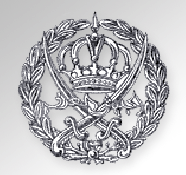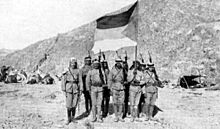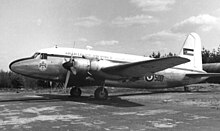Arab Legion
This articleneeds additional citations forverification.(May 2011) |
| Arab Legion | |
|---|---|
| الفيلق العربي | |
 Arab Legion insignia | |
| Active | 22 October 1920 – 25 March 1956 |
| Country | |
| Allegiance | (1920–1946) (1946–1956) |
| Branch | Army |
| Type | Infantry |
| Size | 150 (1920) 12,000 (1949) 22,000 (1956) |
| Garrison/HQ | Zarqa |
| Patron | Monarch |
| Anniversaries | 10 June 1917:Arab Revolt 22 October 1920: Establishment of the Arab Legion 25 May 1956:Dismissal of British officers |
| Engagements | |
| Commanders | |
| Commander (1920–1939) | CaptainFrederick Gerard Peake |
| Commander (1939–1956) | Lieutenant GeneralJohn Bagot Glubb |
| Notable commanders | ColonelJW Hackett, Jr BrigadierNorman Lash |
TheArab Legion(Arabic:الفيلق العربي) was the police force, then regular army, of theEmirate of Transjordan,aBritish protectorate,in the early part of the 20th century, and then of theHashemite Kingdom of Jordan,an independent state, with a final Arabization of its command taking place in 1956, when British senior officers were replaced by Jordanian ones.
Creation[edit]
In October 1920, after taking over theTransjordan regionfrom theOttomans,theUnited Kingdomformed a unit of 150 men called the "Mobile Force", under the command of CaptainFrederick Gerard Peake,to defend the territory against both internal and external threats.[1]The Mobile Force was based inZarqa.80% of its men were drawn from thelocal Chechen community.[2]


It was quickly expanded to 1,000 men, recruiting Arabs who had served in theOttoman Army.On 22 October 1923, the police were merged with the Reserve Mobile Force, still under Peake, who was now an employee of theEmirate of Transjordan.The new force was namedAl Jeish al Arabi( "the Arab Army" ) but was always known officially in English as the Arab Legion. The Arab Legion was financed by Britain and commanded by British officers.[3]The Legion was formed as a police force to keep order among the tribes of Transjordan and to guard the importantJerusalem–Ammanroad.
On 1 April 1926, theTransjordan Frontier Forcewas formed from cadre drawn from the Arab Legion. It consisted of only 150 men and most of them were stationed along Transjordan's roads. During this time the Arab Legion was reduced to 900 men and was also stripped of its machine guns, artillery, and communications troops.
In 1939,John Bagot Glubb,better known as "GlubbPasha",became the Legion's commander, withMajor GeneralAbdul Qadir Pasha Al Jundi as his deputy commander. Together they transformed it into the best-trained Arab army.
World War II[edit]
DuringWorld War II,the Arab Legion took part in theBritish war effortagainst pro-Axisforces in theMediterranean and Middle East Theatre.By then, the force had grown to 1,600 men.
The Legion, part ofIraqforce,contributed significantly in theAnglo-Iraqi Warand in theSyria-Lebanon campaign,two decisive early victories for theAllies.

The top three officers representing the Legion who participated in the Victory March were Major General Abdul Qadir Pasha el Jundi,O.B.E.,Colonel BahjatBeyTabbara, and Lieutenant Colonel Ahmed Sudqui Bey,M.B.E.
1948 Arab–Israeli War[edit]


The Arab Legion actively participated in the1948 Arab–Israeli war.With a total strength of just over 6,000, the Arab Legion's military contingent consisted of 4,500 men in four singlebattalion-sizedregiments,each with their own armored car squadrons, and seven independentcompaniesplus support troops. The regiments were organized into two brigades. 1st Brigade contained 1st and 3rd Regiments while 3rd brigade contained 2nd and 4th Regiments. There were also two artillery batteries with four25-pounderseach. On 9 February 1948 the Transjordan Frontier Force was disbanded with members being absorbed back into the Arab Legion. Although headed by Glubb, now aLieutenant General,command in the field was byBrigadierNorman Lash.
The Legion was initially withdrawn from Palestine to Transjordanian territory, under instruction from theUnited Nations,prior to the end of theBritish Mandate.With the commencement of hostilities the Legion re-entered Palestine with 1st Brigade heading toNablusand 2nd Brigade heading toRamallah.The Arab Legion entered Palestine with other Arab forces on May 15, 1948, using theAllenby,nowKing Hussein,bridge as they were advancing to cover the approaches fromJenin,in the north toAlaffoulaand fromAl-Majame'a bridgeon theJordan RivertoBissanAlaffoula[dubious–discuss].[citation needed]
There was considerable embarrassment from the UK government that British officers were employed in the Legion during the conflict and all of them, including abrigadecommander, were ordered to return to Transjordan. This led to the bizarre spectacle of British officers leaving their units to return to Transjordan, only to sneak back across the border and rejoin the Arab Legion. Without exception all of the British officers returned to their units.[citation needed]One BritishMPcalled for Glubb Pasha to be imprisoned for serving in a foreign army without theKing's permission.[citation needed]
Units of the Arab Legion were engaged in several battles with the Jewish forces, including the following:
- AttackingBen Shemenconvoy atBeit Nabala– 14 December 1947[4]
- Battle ofNeve Yaakovsettlement – 18 April 1948[5]
- AttackingKibutzGesheron 27–28 April 1948[6][7]
- Occupation of theTegart fortatLatrunon 17 May 1948,[8]and later theBattles of Latrunfrom 20 May to 18 July 1948.
- Siege of Jerusalemfrom 17 May to 18 July 1948,
- Attacking and capturing (but later losing)Kibbutz Gezeron 10 June 1948,[9]
- Tarqumiyaon 24 October 1948[10]
By the end of the war in 1949, the Arab Legion consisted of over 10,000 men manning a 100-mile front, which then expanded to a 400-mile front following the withdrawal ofIraqiforces.[citation needed]
Further clashes with Israel[edit]

On September 11, 1956, an Israeli force in what theIDFtermed one of itsretribution operations,Operation Jehonathan,raided Jordanian territory at Al-Rahwa,HebronSector, attacking the police station and clashing with a unit from the Legion'sDesert Force.Over twenty soldiers and policemen were killed.[11]
The Legion generally stayed out of the 1956Suez Crisis.
Jordanian army[edit]
On 1 March 1956, the Arab Legion was renamed as the Arab Army (nowJordanian Armed Forces) as part of theArabization of its command,under whichKing Hussein of Jordandismissed the Legion's British commander"Glubb Pasha"and other senior British officers. In Israel, the Hebrew term "Ligioner" (ליגיונר), i.e. "Legionary" was still informally used for Jordanian soldiers for many years afterwards, also at the time of the1967 warand its aftermath.
Commanders[edit]

- Colonel Frederick Peake( "Peake Pasha" ) – 22 October 1923 – 21 March 1939
- Lieutenant ColonelErnest Stafford( "Stafford Bey" ) 2nd IC—1924–1931.
- Lieutenant General John Glubb,KCB,CMG,DSO,OBE,MC( "Glubb Pasha" ) – 21 March 1939 – 1 March 1956
- Major GeneralAbdul Qadir Pasha Al Jundi,O.B.E. ( "Abdul Qadir Pasha" ) - 1–25 March 1956
Note: "Pasha"is a Turkish honorary title, one of various ranks, and is equivalent to the British title of" Lord ".Beyis equivalent to a knighthood or "Sir".
References[edit]
- ^Pollack, Kenneth,Arabs at War,Council on Foreign Relations/University of Nebraska Press, 2002, p.267
- ^Pike, John."The Chechen Chronicles '98".Globalsecurity.org.Retrieved2014-05-13.
- ^Shlaim, Avi (2007),Lion of Jordan: The Life of King Hussein in War and Peace,Allen Lane,ISBN978-0-7139-9777-4,p.17
- ^Morris, 2008, p. 105
- ^Gelber, Yoav,Palestine 1948: War, Escape and the Emergence of the Palestinian Refugee Problem,Sussex Academic Press, Brighton & Portland 2006 (2nd edition), p. 90
- ^Tal, David (2004).War in Palestine, 1948: Israeli and Arab Strategy and Diplomacy.Routledge. p. 202.ISBN978-0-203-49954-2.
- ^"Truce commission warns Abdullah".The Palestine Post.2 May 1948. p. 2.Retrieved28 July2022.
The attack on Gesher settlements... by... Trans-Jordan
- ^Morris, 2008, p. 132
- ^Morris, 2008, p. 230
- ^Morris, 2008, p. 332
- ^Morris, Benny (1993)Israel's Border Wars, 1949 - 1956. Arab Infiltration, Israeli Retaliation, and the Countdown to the Suez War.Oxford University Press,ISBN0-19-827850-0.Page 392.
Bibliography[edit]
- Dupuy, Trevor N, Elusive Victory,The Arab-Israeli Wars,1947–1974, Hero (1984)
- Farndale, Sir Martin,History of the Royal Regiment of Artillery,The Years of Defeat, 1939–41, Brassey's (1996)
- Glubb, John Bagot,The Arab Legion,Hodder & Stoughton, London (1948)
- Isseroff, A.,Kfar Etzion Remembered: A History of Gush Etzion and the Massacre of Kfar Etzion,2005.
- Levi, I.,Jerusalem in the War of Independence( "Tisha Kabin" – Nine Measures – in Hebrew) Maarachot – IDF, Israel Ministry of Defence, 1986.ISBN965-05-0287-4
- Pal, Dharm,Official History of the Indian Armed in the Second World War,1939-45 - Campaign in Western Asia, Orient Longmans (1957)
- Roubicek, Marcel,Echo of the Bugle, extinct military and constabulary forces in Palestine and Trans-Jordan 1915,1967, Franciscan (Jerusalem 1974)
- Shlaim, Avi (2007).Lion of Jordan: The Life of King Hussein in War and Peace,Allen Lane.ISBN978-0-7139-9777-4
- Vatikiotis, P.J. (1967).Politics and the Military in Jordan: A Study of the Arab Legion, 1921-1957,New York, Praeger Publishers.
- Young, Peter (1972).The Arab Legion,Osprey Publishing.ISBN0-85045-084-5andISBN978-0-85045-084-2
- Jordan – A Country Study,U.S.Library of Congress
External links[edit]
- Arab LegionatEncyclopædia Britannica
- Rothwell, SteveThe Arab Legionat British & Commonwealth Orders of Battle
- The Arab Legion and the Defense of JerusalemfromDefending the Faith: The Hashemites and Jerusalem,a Jordan Media Group publication, 1994 via jordanembassyus.org archived atInternet Archive
- 1956 - King of Jordan sacks British generalatOn This Day,2 March 2008BBC News Online
- Arab Legion
- 1948 Arab–Israeli War
- Arab nationalist militant groups
- Military history of Jordan
- Military units and formations of Jordan
- Military units and formations established in 1920
- Military units and formations disestablished in 1956
- 1956 disestablishments in Jordan
- Military units and formations of the British Empire in World War II
